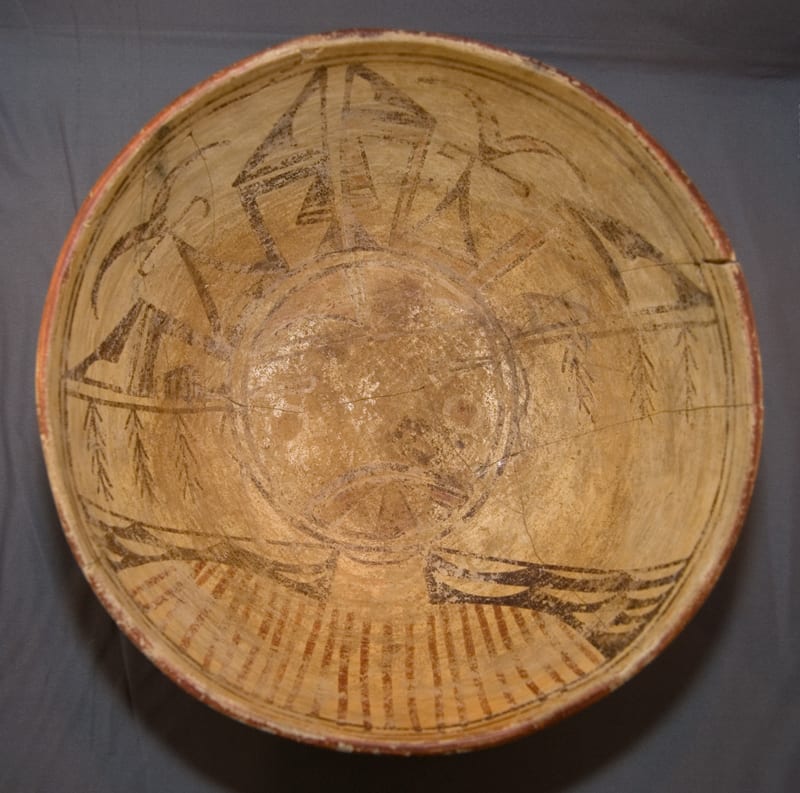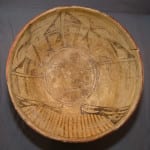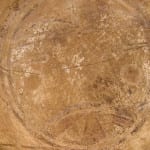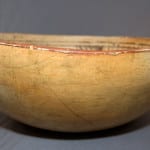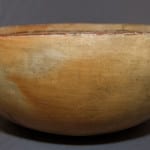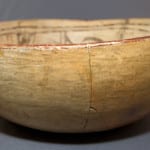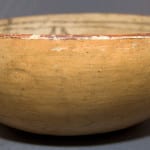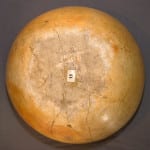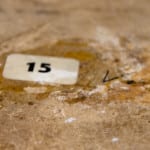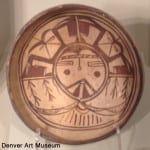Walpi Polychrome Piki Bowl (repaired) with Pahlik Mana interior by Nampeyo, circa 1890. “Broken and glued with no additional plaster or overpainting. There is extensive ethnographic wear to the interior painted design from extended use as a piki bowl. The bowl bears a white paper label reading #15 on the bottom exterior signifying its place in Richard M. Howard’s original pottery collection, collected circa 1950’s.” —–statement by Steve Diamant (seller), Fine Arts of the Southwest. Diamant acquired the piki bowl from Dick Howard’s sister, who is the administrator of his estate.
Dick Howard told Ed Wade the story of bowl 2009-17:
“He (Dick Howard) had acquired the vessel directly from Fannie Nampeyo who maintained that it had been her mother’s (Nampeyo’s) piki bowl. The painting of the Polik Mana is true to the hand of Nampeyo and I have no reason to doubt it to be her work…Dick told me, and others, the story of Fannie and the bowl directly in 1967 and a few times afterward. For seasonal Park Service Rangers (in Mesa Verde) Dick conducted evening classes on pueblo pottery. The price of attendance was a six-pack of Coors. Dick addressed this bowl as a lesson in how pueblo potters retain heritage objects from family and clans, in this case Fann(ie’s) mother, Nampeyo….Dick exhibited your bowl during his talks and it left an impression since all of Dick’s other vessels were in such pristine condition, that this roughly glued together pot stood out…I have a series of photos of Dick(‘s) Mesa Verde house with the bowl sitting on a shelf.” (Ed Wade, emails to me 9/6 to 9/26/09, on file)
On October 7, 2009 I had a chance to speak with Robert Nichols, a Native and folk art dealer in Santa Fe, about Dick Howard, who had been a good friend. Robert has much of the documentation for Dick Howard’s collection and he was kind enough to provide me with a photocopy of the first page of Dick’s first pottery catalog. Though, as Nichols noted, these were not the first pots collected by Howard, this is the first catalog list he created for his collection. The page notes 27 pots. Of the first 20, the first 12 are from Acoma, number 13 is from Cochiti, and numbers 14 through 20 are marked “Hopi.” The price of #15 (presumably the same pot as 2009-17) is marked as $0.00. According to Nichols, Dick Howard frequently traded groceries for pottery “in the early days,” since grocery stores were distant from the reservation and food was immediately useful to First Mesa families. Pots purchased with groceries were (apparently) noted with a purchase price of “$0.00.” Three such pots are noted among the pots listed on this first catalog page.
It would be nice if the entries were dated; they are not. Given his knowledge of his friend’s life, Nichols estimated that these early purchases would have been made in the mid-1950’s when Dick Howard was in his early 20’s and had begun buying and trading native pottery. It would also be useful if Dick Howard had given a more specific description of “#15: Hopi,” but the information we have from the catalog is compatible with Ed Wade’s understanding of the history of bowl 2009-17. (A copy of the catalog page listing pot “#15: Hopi” is on file.)
At first glance, indeed even after a long look, bowl 2009-17 has the appearance of a Polacca “C” bowl. Form and design are the same. The Pahlik’Mana design, plain exterior, red lip, and thin framing lines are characteristic of many Polacca ware bowls in the Keam Collection at Harvard.
The only other pot in this collection that is by Nampeyo and has a red lip is 2012-08.
The Keam collection contains more than 160 Polacca “C” bowls with Kachina and clown designs (Wade and McChesney 1981:145-172), many of them the Pahlik’Mana. Judging from small black and white photographs, many of the bowls have designs very similar to the design on bowl 2009-01. Notice especially two bowls: P.M. # 43-39-10/25659 and P.M. # 43-39-10/25184 (Wade and McChesney 1981:163 and 170). These two bowls and bowl 2009-17 in the collection may have been painted by different hands, but the design elements of the three bowls are close to identical. They exhibit the same Polik’Mana design, red rims, their design is framed by two thin lines, and all three bowls have an undecorated exterior. It would take a practiced eye to distinguish bowl 2009-17 from a well-made but generic Polacca bowl with the same design elements.
Believing bowl 2009-17 to be “Polacca C” ware, both Dick Howard and Ed Wade originally dated it as made about 1880. Apparently Dick Howard affirmed this date for the 50+ years he owned the bowl. Only recently, after closely examining photographs of the bowl’s surface, did Ed Wade retype the pot as “Walpi Polychrome” and revise his estimate of production to about 1890-1895.
According to Wade, “(Walpi) Polychrome was a brief experimental ware transitional between Polacca D and what would become the Sikyatki Revival. (It displayed) a medley of designs both derived from Polacca as well as prehistoric (ware). By 1905 it had pretty much vanished…Recent typologies…have tended to discard the nomenclature since so few such vessel(s) exist” (Wade emails, 9/24 and 9/26, on file).
“Walpi Polychrome” was first defined by Harold Colton as “designs similar to Polacca Polychrome which has a white slip…Surface Finish: smooth to polished” (Colton 4/16/56:ware 7B, Type 18). Dittert and Plog explain that “the main attribute that separates (Walpi Polychrome) from Polacca Polychrome is the lack of a slip; additionally both the red and black paints have a brownish hue. In terms of decorative features, there are more parallels with Polacca Polychrome than differences” (1980:140). These descriptions seem to fit bowl 2009-17 perfectly.
The exterior of the bowl is clearly undecorated, stone-polished, unslipped, fire-blushed yellow ware. The interior of the bowl seems to be white slipped and stone polished but does not exhibit the crackled texture characteristic of the kaolin slip used on Polacca ware. Ed Wade believes this visual assessment of the interior is in error. He believes the interior is unslipped and stone polished with the design painted directly on the clay body of the bowl. What appears to be an interior slip is a patina consisting of the residue of piki batter and the rubbing of the piki maker’s hand scraping the last bits of batter off the bowl. Close examination of the interior with a magnifying glass confirms this analysis. While at first glance the Polik’Mana design seems worn, a closer examination reveals that the design is completely intact but is obscured by a white patina that covers it. If the interior had been white-slipped, this slip would be below the design, not above it. Thus bowl 2009-17 is accurately described as “Walpi Polychrome” and not the earlier Polacca Polychrome type. For another Nampeyo bowl in this collection that was made about the same time as bowl 2009-17 and might best be typed as “Walpi Polychrome” because of its transitional design and finish, see bowl 2009-08.
For another Walpi Polychrome bowl with a Pahlik’Mana interior design and a plain exterior, see Dittert and Plog (1980:37). The one photograph I have of this bowl does not show enough of the interior to allow it to be described accurately.
In a conversation March 13, 2010, Ed Wade pointed out that the lack of Polacca slip on bowl 2009-17 might have had nothing to do with aesthetic sensibility or an evolving ceramic tradition. Since the crackled slip of Polacca ware easily flakes off, it is inappropriate for a piki bowl that is constantly rubbed by fingers gathering batter. The crackled kaolin slip would quickly wear off into the batter and be ingested. Since clay is not an ingredient in piki recipes, Nampeyo probably left the bowl unslipped for gastronomic reasons.
The Pahlik Mana interior design on bowl 2009-17 is shown from the mid chest level up. Her shirt is represented by 23 vertical red lines. Her left shoulder is somewhat lower than her right and the monochromatic background to her shoulders is similarly skewed. This imbalance is emphasized by a line that runs completely across the design below the head and is downward slanted on the right side of the bowl.
The Pahlik Mana is a butterfly dancer and is not considered a kachina. When appearing in the plaza during the fall social dances, she wears an elaborate headdress of linear and curvilinear elements that are symbolic of rain clouds, corn, and fertility (Branson 1992:173). On bowl 2009-17, her headdress has these same two basic motifs, one linear, the other curvilinear. The linear designs are spread out like banners flying from vertical “flagpole” forms and consist of a somewhat rectangular element with imbedded (and varying) triangular design(s) along the flag-pole edge. Topping each rectangle is a triangular form with a negative white image. Two of these linear groupings “fly” back-to-back from a central “flagpole” on the headdress. The remaining two linear groupings are oriented so their attached “flag poles” form the lower edges of the headdress. From this lower edge hang three prayer feathers on each side of the central head.
The curvilinear motifs consist of curved triangles with a crosspiece at the apex, topped by two swags that form a flower-like finial. The two curvilinear designs imbedded in the headdress are interspersed between the three linear designs.
The headdress is monochromatic except that 1) the curvilinear swags seem to have red interiors and 2) on the right side of the bowl (but not the left) the interior of the linear elements have also been painted red
Because of the patina caused by ethnographic use, the central image on bowl 2009-17 is somewhat obscured but (as noted above) is complete and can be discerned with the aid of a magnifying glass. One third of the way down the face a line cuts across the image. Above this line is the forehead, creased with two flattened half circles and a vertical element that extends and becomes the central “flagpole” of the headdress. There are vestiges of red paint above the curvilinear elements. Below the forehead the composition is rather simple: two slit eyes, below them two red dots on the cheeks, each set off with a white circle. The mouth is situated below a curved black line and is characteristic of the Pahlik’ Mana: three red triangles interspersed by two white triangles. Simple curved lines indicate ears. Three horizontal red lines topped by one horizontal black line indicate the neck, their direction contradicting the vertical red lines of the shirt below.
In short, bowl 2009-17, although Walpi Polychrome, uses exactly the same Polik’Mana image as Polacca “C” bowls with this design. Bowl 2009-17 is thus a transitional pot and this function gives it particular importance in Nampeyo’s career and the history of Hopi/Hopi-Tewa pottery.
Steve Diamant and Ed Wade date bowl 2009-17 as having been made about 1890-1895. Assuming they are correct, this turns out to be a particularly crucial period in the development of Nampeyo’s style. Nampeyo would have been about 30 years old when she made bowl 2009-17; her design career would extend about another 30 years until she became substantially blind. Nampeyo’s fame rests on her revival of ancient designs during the last 20 years of this painting career, 1900 to about 1920. Bowl 2009-17 offers us a rare glimpse into the development of her aesthetic style before 1900.
See Appendix B for a discussion of bowl 1993-04 in this collection for a discussion of the impact of ancient Sikyatki pottery on the development of Nampeyo’s style. That discussion argues that Nampeyo experimented with reproducing Sikyatki style pots as early as 1880 and that by reproducing ancient designs Nampeyo learned her distinctive Sikyatki Revival style. Stephen reports that Nampeyo was using designs from “ancient ware” in 1893 (1936:130). The earliest photographs we have of Nampeyo creating Sikyatki Revival pottery also are dated 1893 (Kramer 1996:48-49 and 167; Struever 2001:29). The year 1893 is exactly at the midpoint of the 1890-1895 time frame Diamant and Wade define as the production date of bowl 2009-17.
Nampeyo may have experimented with ancient Sikyatki designs as early as 1880, but bowl 2009-17 is evidence that more than ten years later she was still making bowls that (except for their lack of a white slip) were indistinguishable from the Polacca “C” ware. Sikyatki Revival was not the sudden flash of inspiration inaccurately described by Fewkes and repeated endlessly in the literature. Apparently Nampeyo simultaneously produced pottery that had the ordinary Polacca designs of her day and also experimented with the revival of ancient designs. One might speculate that the proportion of her work that reflected Sikyatki sensibilities increased during this period, but bowl 2009-17 is evidence that the transition to Sikyatki Revival took more than 10 years.
By the 1920s, Nampeyo’s painting career had largely ended because of blindness but she was hailed as a “genius” based largely on her oeuvre of Sikyatki Revival design (Bunzel 1972:88). Was there any hint of this genius in the design of 2009-17? Perhaps, but only a bit.
In “Appendix B” I defined six distinctive characteristics of Nampeyo’s Sikyatki revival pottery:
1) A tension between linear and curvilinear elements, often represented as a contrast between heavy and delicate elements;
2) A deliberate asymmetry of design;
3) The use of color to integrate design elements;
4) The use of empty (negative) space to frame the painted image; and
5) The use of a thick above a thin framing line on the interior rim of her bowls.
6) Nampeyo’s painting is confident, bold, and somewhat impulsive compared to the more-studied, plotted and careful style of her daughters, descendants and other Hopi and Hopi-Tewa potters.
Of these six stylistic techniques that later characterized Nampeyo’s Sikyatki Revival work, only two are clearly present in the design of bowl 2009-17, two are clearly absent, and presence of the final two techniques is problematic.
Techniques #2 and #3 are clearly present on bowl 2009-17 and are also representative of Nampeyo’s later work:
Asymmetry of design:
2) While at first glance the overall design seems quite symmetrical, the execution of the design is not balanced. The central “flag pole” of the headdress extends into the forehead, but, if visually extended across the remainder of the image, does not equally bisect it. The form of the headdress is symmetrical, but elements painted red on the right side of the bowl are black on the left side of the headdress. The rectangular and triangular designs that compose the four linear elements in the headdress are different sizes, though the overall dimension of the four linear designs is the same. The four rectangular elements in the headdress all contain small embedded triangular elements, but in all four cases these elements are different. The left shoulder of the Pahlik’Mana (right side of the bowl) is lower than the left. The slanted line that runs across the design just below the head emphasizes this imbalance, giving the image rightward motion and energy.
The use of color to integrate the design:
3) On bowl 2009-17 the red shirt visually connects to the red mouth elements, red cheek circles, red upper forehead and red elements in the headdress. These areas of color pull the image together. (Imagine, for example, if the headdress were simply painted black. The headdress would seem to simply sit on top the face design rather than be part of a single visual pattern. The same could be said if the shirt had been painted all black: the head would seem to simply sit on the shoulders.)
Techniques #4 and #5 are clearly absent on bowl 2009-17 although they are representative of Nampeyo’s later work:
The use of empty space to frame the design:
4) In contrast to her later Sikyatki Revival bowls, on bowl 2009-17 Nampeyo did not use empty (negative) space frame the painted image. The interior of 2009-17 is treated like a canvass and completely covered with design. Apparently this lack of sensitivity to the use of negative design space is characteristic of Polacca ware (Wade and McChesney, 1981:143), which bowl 2009-17 strongly resembles.
Framing lines:
5) While there are framing lines, these are of equal (thin) width and not the thick-above-thin line characteristic of Nampeyo’s later Sikyatki revival bowls. As noted above, two thin framing lines are part of the Polacca ware convention.
Finally characteristics #1 and #6 of Nampeyo’s later Sikyatki Revival style are present to some extent in the design of 2009-17, but the reasons for these patterns are not clear and cannot be attributed to Nampeyo’s talent:
A tension between linear and curvilinear design elements:
1) The literature contains many images of Polik’Mana designs made over a period of almost 150 years. The depiction of the Polik’Mana seems quite conventionalized for this long period of time, though there is variation in design given the varying abilities of the painter. [For another Walpi Polychrome bowl displaying the image of a Polik’Mana image on its interior, see Dittert and Plog (1980:37).]
Since the Polik’Mana is a familiar dancer in the villages, the similarity of her depiction across time might simply represent a common agreement to represent her accurately. Thus almost all depictions of this dancer show a headdress with alternating linear and curvilinear motifs. [A 1950 photograph/postcard of Janice Quotskuyva (Janice Day) as Polik’Mana is on file.] The design on bowl 2009-17 also shows this alternating pattern, but it is difficult to make the claim that the pattern here represents a unique Nampeyo talent.
However, the vertical lines of the Polik’Mana’s shirt on bowl 2009-17 are contradicted by the curved design just above it. Rectangular eyes are juxtaposed to round cheek circles. Again, however, this tension may be due to convention a desire to represent the Polik’Mana accurately and not represent any special Nampeyo talent.
Moreover, the painting of the design on bowl 2009-17 seems uniformly light and the contrast between heavy (linear) and delicate (curvilinear) elements characteristic of Nampeyo’s later work is not present on bowl 2009-17. In short, the design on 2009-17 does display a tension between linear and curvilinear elements that characterized Nampeyo’s Sikyatki Revival work, but this pattern may be due to convention rather than the special geniusof the potter.
Confident, bold and impulsive painting:
6) Perhaps because the depiction of the Polik’Mana is quite conventionalized, the design on 2009-17 seems more studied than much of Nampeyo’s Sikyatki revival pottery. Nevertheless, there is some of the impulsive painting on bowl 2009-17 that characterizes Nampeyo’s later work: First, about half of the 23 red lines that form the shirt cross the inner framing line. Second, as noted above, rectangular and triangular elements are used to form the linear elements in the headdress. While the total length of these linear elements is the same, the proportion of design devoted to the rectangular element varies. (Hence the proportion devoted to the triangular element inversely varies.) Third, all four of the rectangular designs in the headdress have imbedded triangular elements, but each of these imbedded designs is different than the other three. This asymmetry may be another indication of impulsive painting. Again, however, these design characteristics are not unique to bowl 2009-17. Many can be found on Polacca bowls in the Keam collection. It is an intuitive judgment, but the overall painting on bowl 2009-17 looks confident, as if painted by a skilled potter, perhaps Nampeyo.
In short, on bowl 2009-17 there are only hints of the evolving style that 30 years later would be seen as “genius.” This analysis reinforces Barbara Kramer’s observation that “Few photographs and vessels from (pre-1900) are extant, but it can be deduced that Nampeyo had not yet found her personal style” (1996:177).
The lack of such markers of “personal style” on a bowl made in the 1890s reinforces the
suggestion first made in the catalog entry for bowl 1993-04: perhaps it was by copying the “Bird Hanging from Sky Band” design of an ancient pot that Nampeyo developed her distinctive style.
If the design on bowl 2009-17 does not reflect her later Sikyatki Revival style, how does the design on 2009-17 compare to similar pottery that has been attributed to Nampeyo?
Unfortunately it is difficult to find comparable Nampeyo pots:
Only a few Polacca “C” or “D” pots by Nampeyo are known; within my limited knowledge, bowl 2009-17 is the only Walpi Polychrome pot by Nampeyo that is known. Thus I have to scramble a bit to find pottery to which bowl 2009-17 can be compared.
I will discuss the few pieces of (pre-1900) Polacca ware that are documented as made by Nampeyo. After that I will discuss two newer Sikyatki Revival pieces by Nampeyo with the same Palik’Mana design seen on 2009-17.
By far the best-known Polacca “D” pot by Nampeyo is a canteen given by her in the 1890’s to Dr. Joshua Miller in payment for his treatment of her eyes. (She would become functionally blind in about 20 years.) Upon Miller’s death in 1901, the canteen was given to the Arizona State Museum (catalog #4099). A large photograph of the Miller canteen is reprinted in Dittemore (1990:61); additional images are in Kramer (1996:147) and the Blairs (1999: Fig. 2.15 facing page 172). I took a close-up of the canteen’s Pahlik Mana design during the museum’s Seven Centuries show in the 1990’s and that photograph is reproduced here. These sources estimate a production date from circa 1880 to 1901. The Museum that owns the canteen cites the earliest date in this range: circa 1880, roughly ten years earlier than attributed to bowl 2009-17 in this collection.
Both the form and design of the Miller canteen are used as the “gold standards” for evaluating Polacca ware believed to have been made by Nampeyo. It is against this standard that the origin of bowl 2009-17 must be evaluated. The provenance of 2009-17 is reinforced by the statements made fifty years ago by Fannie Nampeyo to Dick Howard but the assertion that bowl 2009-17 was made by Nampeyo must first be established by comparing its obscured design to the clear image on the Miller canteen.
To my eye there are some similarities but perhaps more differences between the Miller canteen and bowl 2009-17. Both are more carefully-painted than many of the Pahlik Mana bowls in the Keam collection. Both have red elements on the right but not the left side of the headdress. (Since the Wade and McChesney [1981] photographs are in black and white, I cannot tell is such use of color is typical or is particularly characteristic of Nampeyo.) On both the canteen and bowl the curvilinear element in the headdress is built of the same elements. Both are asymmetric, though the Miller canteen is less so than the 2009-17 bowl.
However, the Miller canteen is more-carefully painted than bowl 2009-17. The treatment of the Pahlik Mana face is differently constructed on the two pots, as is the treatment of the shirt. The image on bowl 2009-17 in this collection has a feather cloak over its shoulder, the image on the Miller canteen does not. The kachina on the Miller canteen has arms; bowl 2009-17 does not. One would not expect an artist to draw exactly the same design on a canteen and a bowl, but I cannot judge if the variance in design indicates different makers or the same potter (Nampeyo) working at different times with different shapes of pottery.
I know of seven other Polacca ware pots attributed to Nampeyo:
The first Polacca pot by Nampeyo is a “helmet-shaped” stew bowl and its design has no particular relevance to 2009-17 (Collins, 1974:27).
Second is a Polacca bowl depicting a Qooqoqlo katsina, so of course the headdress (birds) and the face look very different than the Pahlik Mana image on 2009-17. However, the shirt of the Qooqoqlo is composed of parallel vertical red lines, as on 2009-17 (Struever, 2001:27). (Numbers of bowls in the Keam collection also have shirts represented by parallel lines, though I do not know their color.) The quality of design of the bowl published in Struever (1981) and bowl 2009-17 in this collection look similar, though this is a nebulous judgment.
The third is a white-slopped bowl with a Polik’Mana design that is in the collection of the National Museum of the American Indian (catalog number 10/5536). Dated circa 1900, the image includes arms and (from the image I can see) the design is more balanced than that on piki bowl 2009-17. Characteristic of Nampeyo’s bowls, the NMAI bowl seems to have an extra rim coil of clay and thick over thin framing lines; uncharacteristically these framing lines have spirit breaks. From the angle of the photograph I cannot tell if the design of this bowl contains a feather cloak or stripped shirt, as on bowl 2009-17 in this collection. [Photograph on file.]
Fourth is a canteen offered at auction by Bonhams & Butterfields December 6, 2010 and identified as “attributed to Nampeyo.” From what I can tell from one photograph (on file), the design of the Bonhams & Butterfields canteen is more balanced in both the form and color of the design than bowl 2009-17 and there is more use of open space to set off the image. Unlike bowl 2009-17, the design of the Bonhams & Butterfields canteen lacks a feather cloak or stripped shirt and depicts arms. The painting is “confident” on both pots.
Fifth is a Polacca canteen that is quite similar to the Miller canteen and formerly part of the Wade collection. A photograph of this second canteen is referenced in Ed Wade’s evaluation of 2009-17, below. While the size of the curvilinear elements in the headdress on this canteen is larger than on bowl 2009-17, the shape of these elements is very close to bowl 2009-17. As on the bowl in this collection, one linear motif in the headdress on the canteen is painted black while the corresponding design on the other side is painted red. Both bowl 2009-17 and this second canteen have the same face elements. Both depict feather cloaks thrown over the shoulders of the Palik’Mana and neither design depicts arms. The Wade canteen, however, lacks the stripped shirt seen on bowl 2009-17.
Sixth is a bowl in the archeology collection of Wesleyan University and is cited by Ed Wade in his evaluation, below. Judging from the small photograph he provides, the Wesleyan bowl is white-slipped Polacca ware with a red rim and two thin framing lines above the Polik’Mana image. The curvilinear element in the headdress on the Wesleyan bowl is somewhat different than on bowl 2009-17, otherwise the design of the two bowls are identical. Neither bowl depicts arms on the image, both show feathered cloaks and stripped shirts . Both bowls seem made by the same hands.
Seventh and finally is a bowl reproduced and discussed by Jesse W. Fewkes in the Thirty-Third Annual Report of the Bureau of American Ethnology (1919):
“The most common figure on the third epoch of Hopi pottery, commonly called modern Tewa and manufactured up to 1895 by Nampeo, a Hano potter, is a representation of the Corn maid, Shalako mana…Her picture on Hano pottery is shown in figure 108.” (1919:275-276. Also see Fewkes. 1973:173-174)
From the photograph, it is not possible to tell is this bowl is white-slipped or not. The image shown by Fewkes is in black-and-white, but variations in shading are clear and I assume they represent red and black paint. As on 2009-17, the design is not balanced, with curvilinear elements in the headdress probably painted red and a stepped element (not seen on 2009-17) painted black. Both bowls have linear Z-shaped elements near the top of the headdress and on both one is painted red and the other black. This apex of the headdress is very similar on the two bowls, with only slight variation of form and spacing. On both bowls three elements hang from the bottom edge of each side of the headdress. On bowl 2009-17 in the collections these seem like feathers or pine boughs; the Fewkes bowl design looks more like a triangular elements hanging from a string. The face elements on both bowls are essentially the same, though the bowl in this collection had round cheek marks and the Fewkes bowl has triangular elements. The neck and shoulder designs are very similar on the two bowls, though the Fewkes bowl has more “feather cloak” design than the bowl in this collection. The bowl in this collection has 23 red lines forming her shirt, the Fewkes bowl 25. Neither bowl depicts arms on the painted image. On both bowls there is asymmetry of design and color is used to integrate the design. The framing lines are the same on both bowls. On both bowls there is a tension between linear and curvilinear design elements and confident, bold and impulsive painting. (For example, the spacing of the red lines in the shirt is uneven on both bowls.) In short, the two bowls feel like they were painted by the same hand and the Fewkes bowl is identified as by Nampeyo ca 1895 or earlier.
Of pottery by Nampeyo with a Polik’Mana design that are not white-slipped (not Polacca ware), there are two examples that seem strikingly close to the design on 2009-17 and lend credence to Nampeyo as maker of my bowl. The first is a tile now at the California Academy of Sciences; the second is a small dish for sale in 2009 by Andrea Fisher Gallery in Santa Fe.
First, the California tile: One should remember that the demands of creating a design on the small rectangular surface of a tile are substantially different than creating a similar design on a larger round interior of a bowl. Nevertheless, there is a collection of tiles in San Francisco, many of them apparently made by Nampeyo, that might help us judge whether Nampeyo was the maker of bowl 2009-17.
In the first few years of the twentieth century Nampeyo received a commission from Jacob and Maria Breid. Between May 1904 and July 1906 the Breids were employed as doctors on the Hopi reservation. During this time they apparently arranged for Nampeyo to make a set of 70 ceramic tiles, intending to install them around the fireplace mantle of their home. Probably about half of these tiles were made by Nampeyo herself and the rest probably by Annie (the Messiers 2007:34-35). These tiles were subsequently given to The California Academy of Sciences and can be viewed online at: http://research.calacademy.org/research/anthropology/collections/Index.asp
using the search word “Nampeyo” as “maker.”
While these tiles are perhaps 15 years younger than bowl 2009-17, they are a gallery of Nampeyo designs, many of them kachina images. Three of the tiles, like bowl 2009-17, seem to depict the Pahlik’ Mana dancer, #CAS 1987-0003-0026, 0027 and 0028. The design of this last tile seems closest to the interior design on bowl 2006-17. From the neck down, the design on tile #0028 is completely different than the design on bowl 2009-17. There is some asymmetry on the tile design but, in contrast to bowl 2009-17, this is accomplished by tilting the head of the dancer rather than sloping the shoulders. On both the bowl and tile the linear and curvilinear elements of the headdress are composed of the same design elements. The design of the faces is strikingly similar. These similarities lend credence to the assertion that Nampeyo made bowl 2009-17.
Second, a small dish for sale in 2009 by the Andrea Fisher Gallery (Santa Fe) has a Polik’Mana image and is identified as made by Nampeyo. This shallow dish has a design that (from the neck up) is very similar to 2009-17. The construction of linear and curvilinear headpiece elements on the Fisher bowl (though not their order) is very close to the design on bowl 2009-17. The design of the face seems identical, as is the overall “feel” of the painting. Like bowl 2009-17, the Fisher bowl depicts a red-stripped shirt. The Fisher bowl shows only a few feathers on the shoulder of the image, unlike the feather cloak on bowl 2009-17. The Fisher bowl depicts arms; bowl 2009-17 does not. (See the photograph, attached.) In contrast to the bowl in this collection, the Fisher dish has an unpainted rim and the thick over thin framing lines that are characteristic of Nampeyo’s Sikyatki Revival production perhaps 15 or so years after bowl 2009-17 was made.
Although the record is thin, the comparisons that are possible between bowl 2009-17 and
a) Polacca ware pots attributed to Nampeyo or
b) pots depicting the Polik’Mana image attributed to Nampeyo provide support for the assertion that bowl 2009-17 was also made by Nampeyo. There is substantial variation in format and design among these 10 pots, but bowl 2009-17 clearly fits into the range of this variance. The last two Polacca bowls discussed above (#6 and #7) are strikingly similar to bowl 2009-17. Bowl #7 is particularly noteworthy since it is contemporaneously documented by Fewkes as made by Nampeyo in 1895 or earlier.
Ed Wade evaluated bowl 2009-17 as follows:
———-
The renowned Hopi potter Nampeyo (1860 – 1942), as with her San Ildefonso counterpart Maria Martinez, was expert at a number of ceramic stylistic and technical forms and traditions. Her most immediately recognizable style is characterized by vessels with an ivory colored surface (resulting from the use of coal in the firing process) and compositions derived from the prehistoric Sikyatki Polychrome style, which flourished A.D. 1375 – 1625. Less well known was her early experimentation with figurative animal and human designs, one of which is beautifully illustrated on this deep-basined bowl that sports an abstracted Katsina supernatural being.
The letters and records of late 19th- and early 20th-century Hopi trading post operator Thomas Keam (now housed at the Peabody Museum, Harvard) document the work of two women who specialized in such representational compositions, beginning in the 1880s and continuing into the first decade of the 20th century. One of these is Nampeyo. The other, very scantily documented, is associated with the name Paelae. Both were members of the Corn Clan and apparently they knew one another. Their figurative styles were very similar but to the discerning eye the hand of Nampeyo is distinct from that of the other potter. Nampeyo favored diminutive bodies on her anthropomorphs, which in her post-1895 compositions typically had upturned arms and hands holding feathers, bows and arrows, and rattles. Pre-1895 bodies were simpler, as with this bowl, with elongated neck and rounded upper torso painted with red and black vertical lines. In contrast to the body, the heads of human-like creatures were large, often double or more the size, with elaborate headdresses and face paint. The shoulders are generally draped with a feather-like cloak.
An elaborate headdress surmounts the head of the Palhikmana or “Flower Girl – Water Bearer” which has been adapted from the arabesque inner lip designs common to 19th-century Hopi stew bowls. The circular faces exhibit rectangular eyes with central slits; ears are simply loops, often adorned with pendant square crosshatched earrings, and a central drop head pendant extending between the eyes. Most of these traits can be seen in the painting dominating the basin of this bowl. Additionally Nampeyo provides decorative details to signify the gender of the representation as with the circular red dots upon the cheeks of the face.
A number of documented Nampeyo vessels with this same imagery are found in various private and university collections. An example is this 1890 Polacca bowl in the Wesleyan Museum: [photo removed]
Another is the famous Dr. Joshua Miller canteen by Nampeyo in the Arizona State Museum (ASM # 4099), presented to the doctor as a gift by the potter in 1901.
An additional canteen by Nampeyo formerly in my own collection shows another variant of this same composition.
Only two vessels that I know of have been documented as the work of Paelea and both reside in the Pitt River museum in England, donated in 1913.
In this canteen the most marked difference from the composition of Nampeyo is seen in the loose rendering of the body whereas other undocumented Katsina forms painted on tiles and tourist bowls are even more divergent: [photo removed]
In addition to stylistic traits, this bowl is identified as the work of Nampeyo by its personal history, related to me by its original collector, Richard (Dick) Howard. I first became acquainted with this object in 1968 when serving at Mesa Verde National Park as a seasonal ranger. Dick was the Senior Ranger at that time charged with the training of seasonal personnel. As part of his instruction he held evening Pueblo pottery classes, using items from his outstanding ceramic collection as teaching aids.
Dick was renowned as the most knowledgeable scholar on the subject as well as an intimate to then contemporary native potters. One of his close associates was Nampeyo’s youngest daughter Fannie Nampeyo (1900 – 1987) whom he had met when first collecting in 1954. The catalogue number of 15 on the bottom of the bowl indicates it was collected within the first two years of his acquisitions.
Among his many lessons Dick emphasized that potters were themselves collectors of heirloom items passed down through the generations. This bowl was used as an example during the discussion since he had acquired it directly from Fannie who stated that it had been her mother’s piki bowl. Dick was punctilious about details and there is no reason to doubt the veracity of the story.
Equally as important as the beauty of this fine object is its historic position in the origins of commercial Indian painting. Little acknowledgment has been given to women potters for their role in the development of late-19th-century flat painted figurative compositions on clay, which would directly lead to the 20th-century institution of Indian easel painting. Nampeyo’s composition here is no different, except for superior quality, than similar drawings made by men for sacred mural paintings and for commissions from early frontier anthropologists like Jesse Walter Fewkes. In many ways Nampeyo has intellectually approached this dynamic composition as though she were painting on canvas.
This bowl is a compellingly beautiful object, with enduring aesthetic and intellectual worth, which would complement any serious collection of Pueblo ceramic and paintings.
Edwin L. Wade, PhD.

